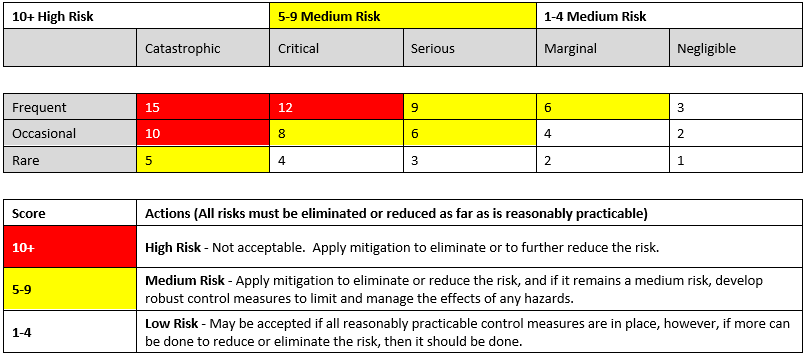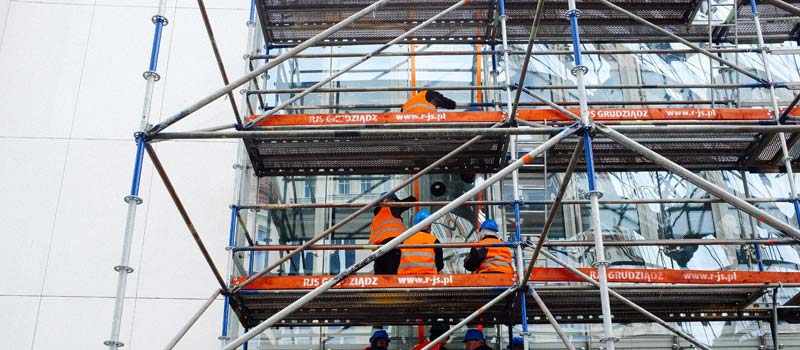Construction Site Risk Assessment (Health and Safety)

How do you stay safe on site? Construction sites have more risks than most working environments and so extra care is needed for the health and safety of everyone involved.
Risk assessment is all about assessing and minimising risk. However, when working on a construction site, anticipating the building risks, and putting strategies in place to prevent accidents is a much higher priority than if you were working in an office environment.
So here is some information on Construction Risk Assessment.
What are ‘RAMS’?
RAMS are a quick way of referring to Risk Assessments and Method Statements – two different aspects of site health and safety.
The Risk Assessment does what is says and considers all health and safety risks, whereas the Method Statement shows how you are going to manage the risks in order to meet your legal responsibilities, under the Health & Safety at Work Act 1974.
You have responsibility under law to protect anyone who works or visits your site and to any member of the public who might be affected by the construction works.
What is a Construction Risk Assessment?
The person responsible for health and safety needs to develop a risk assessment plan. Any person undertaking a Construction Risk Assessment needs to be competent – having sufficient knowledge or experience. There are four stages:
- Identify the risks that can be avoided completely and remove them
- Review the risks and potential hazards that cannot be avoided
- Set up processes to control and manage them so that their impact is reduced
- Monitor the effectiveness of the measures
Purpose of risk assessment
A risk assessment can be a simple document but it needs to be comprehensive. It is a means of summarising all the risks following a site visit risk assessment, identifying who could be at risk and a establishing a set of control measures to reduce the risk.
DON’T LET ‘UNEXPECTED COSTS’ TURN YOUR DEVELOPMENT PROJECT INTO A NIGHTMARE.
Download our 16 examples of how costs can escalate if the impact of ‘unexpected costs’ are not considered. Find out what they are and roughly how much each of them could cost you.
A construction risk assessment template can be used but the risk analysis will vary between each construction site and will need include all the risks and hazards that have been identified.
Risk assessment routine
As most developers have projects which will mean more than 5 people are working on site, you will need to have written documentation.
It makes it easier to communicate:
- Site notices for visitors
- Site inductions for workers
- Risk assessments for tasks
- Evidence that reasonable precautions have been considered

Here are the steps to creating a Building Risk Assessment.
1) Identify the risks
Look at every aspect of the construction works. When identifying the risks, here are some areas to include but they are not limited to:
| Site Location | Position of site – On main road – Schools in proximity – Alongside rail line |
| Site Security | Locks – Hoarding – Screening – Access points – Lighting |
| Buildings | Temporary buildings – Storage containers – Demolition of existing structures |
| Equipment | Use of Plant – Use of power tools – Working with heat – Scaffolding – Correct fitting and use of PPE |
| Materials | Storage of hazardous substances (COSHH) – Working with hazardous substances |
| Working Environment | Working at height – Working at depth – Working in confined spaces – Noise – Dust – Vibration – Trip hazards |
| Deliveries | Vehicle access – Manual handling (loading, unloading and lifting) |
2) Identify who and how
You need to consider everyone who may visit or pass by your site as there is the potential for them to be impacted by the construction work.
- Employees
- Subcontractors
- Delivery drivers
- Architects
- Surveyors
- Construction professionals
- Clients
- Visitors
- Neighbours
- Members of the public
3) Evaluate and prioritise
Having identified the risks, they now need to be categorised into ‘HIGH risk, MEDIUM risk and LOW risk’. Here is an example of the criteria for assessing each identified risk.

4) Recording significant findings and identifying control measures
Keep the risk assessment in simple plain English so that they are easy to understand by everyone on the site. For each identified risk, you need to state what is the control measure for the risk, who is responsible for the making sure that the measures are put in place and for monitoring them. Check that the measure in place is proportionate to the risk level.
Method statements assist with the planning of making the site compliant with health and safety requirements and actioning the control measures for each risk.
5) Review the risk
A construction site is changing at each phase of the project and so it essential to update the risk assessment report to take into account new risks. Updates need to be communicated to everyone on site in order to manage risks effectively.
When and how do I notify the HSE?
The Health and Safety Executive (HSE) must be notified before construction commences if it is a notifiable construction project. This can be done online using form F10. You will need to include the following information:
- Location and Local Authority
- Description of the project and the construction works
- Number of people working on the site
- Start date and duration
- Those involved in the project – contact details of client, principal designer, and principal contractor.
The Construction (Design and Management) Regulations – known as CDM regulations – are a set of health and safety regulations that apply to all construction projects. The client has overall responsibility for managing the health and safety on a construction site supported by the principal designer and principal contractor.
What makes a construction project notifiable?
You need to submit a F10 form to notify HSE if your construction project:
- is likely to last longer than 30 working days and has more than 20 workers on site at any one time
- will involve more than 500 person days of construction work.
What construction site risk assessments do I need to carry out?
There are two types of site risk assessments:
- General Assessments – assessing all the health and safety risks to which anyone on the site could be exposed.
- Specific assessment – risk assessment for specific hazards e.g. hazardous substances (COSHH), working at height, manual handling, vibration, dust, and noise to name a few.

What is a construction phase plan?
The plan is a document to show how the health and safety is being planned, organised, and monitored throughout the project so that work can be carried out safely and is a means for everyone to work together to minimise the risks.
What is a health and safety file?
A health and safety file contains all the information which might be needed whilst anyone is working on the construction site – essential if there is more than one contractor working on site for clear communication.
What are thorough examination reports?
Examination reports are a record of the tests and controls in place for all lifting equipment that is used on the construction site. Examples of lifting equipment include but are not limited to cranes, slings, lifts, hoists, forklift trucks – in fact, any equipment that is used for lifting or lowering loads.
What are inspection reports?
Regular inspections need to be undertaken, recorded, and retained for items which include but are not limited to scaffolding, ladders, and excavations.
What is a method statement for construction works?
A method statement is part of RAMS and states how the identified risks will be managed and controlled on a site-specific basis. It also ensures that the safe methods of work have been clearly communicated to those who will be carrying out each task, especially for the higher risk elements of the construction works. Tasks can be adequately planned and appropriate resources put in place to maintain good health and safety outcomes.
What do I do if there’s an injury or accident on my building site?
There must be a clear procedure to follow in the event of an injury or accident on a construction site. Details must be recorded on an Accident / Incident form. If there has been a death, injury, or a dangerous occurrence, it will need to be reported to the HSE under RIDDOR (Reporting or Injuries, Diseases and Dangerous Occurrences Regulations).
Do bear in mind that HSE is not an emergency service and so if immediate medical support is required, emergency procedures as recorded in the Health & Safety file should be followed.
Key documents
In summary, here are the key documents you can expect on a construction site:
- Risk assessments
- Method statements
- F10 notification form
- Construction Phase Plan
- Health & Safety File
- Examination Reports
- Inspection reports
- Accident / Incident reports
You do not need to know how to undertake a construction site risk assessment but you do need to be aware of your responsibilities. A good principal contractor will have the expertise within their construction project management team.
Getting the right project management team on your next development is essential to bring your project to a safe and successful completion.